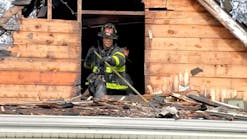Always Be Nice: Treat Everyone With Respect, Kindness, Patience And Consideration
To be effective, we must continually connect a lot of different organizational pieces into the operation of an integrated system. They include our physical assets (stuff) like facilities, equipment, tools, apparatus, electronics, SOPs and software. Very little in our business is automated, so virtually all of these pieces require a real live human to make them operate.
Many times we become preoccupied with the mechanical, manipulative, technical, procedural and tactical parts of our operation. While they are critical to our effective operation, they also require human activation.
The point of this brilliant analysis is that while this part of our inventory is essential to deliver service to Mrs. Smith, it cannot by itself connect to her and with her as a customer. While she may admire the red and chrome and gold leaf, and may be impressed by the blinking/flashing light emitting diodes, when the chips are down and she is in a bind, the hardware and software become transparent to the person in trouble who needs help.
The only part of the system the customer will focus on, really care about or remember very long is the human part of the system who directly delivers service and who touches them as a human in a human and caring way. Simply, it’s difficult to really believe a digitized pre-recorded electronic voice when it says it cares about you.
This human-to-human process begins with the initial call to request assistance. Mrs. Smith could care less that we have a space-age 911 electronic, nano-second, pass-through, computer-driven call receipt and dispatch system, with automatic address/phone verification capability and an instantaneous satellite-driven vehicle locator and an on-line computer terminal in the front seat of every vehicle that is painted red. Rather, she instantly connected with the voice and helpful feeling she re-ceived from a heads-up, calm, professional communications center human.
When Mrs. Smith sent the personal message that she was in trouble, the dispatcher sent a personal message back to her that the system cared about her and help was on the way — at that critical initial stage, the human (dispatcher) became the entire fire department to Mrs. Smith. As the event continued to evolve, Mrs. Smith somehow forgot to ask about the results of the last pump test on the rig that pulled up on side A at her home.
She will typically remember and relate (two-page letter to the fire chief a week later) three basic observations about our service — none of it mentions pump test results (or anything else very technical):
Number 1 — Quick response time. “It seemed you arrived as I was hanging up the phone.”
Number 2 — Skillful performance that solved the problem. “Your firefighters were so calm and took charge. Everything got better after they arrived.”
Number 3 — Positive personal treatment. “Everyone who responded was so kind, and I will never forget how nice they were to my family and me.”
Numbers 1 and 2 - (QUICK/SKILLFUL) each got a nice three-sentence paragraph.
Number 3 - (NICE) gets a full page and a half from Mrs. Smith.
As fire department operational participants concerned with the long-term impact and effect of service to the customers within our community, we are absolutely compelled to examine the most consistently important and memorable part of the service delivery experience to the customer — being NICE. When we receive feedback, observe, review, critique, listen and examine being nice within a fire department service delivery context; it involves the basic behaviors of respect, kindness, patience and consideration.
Nice isn’t some blue sky, smiley-face program — it is a definitive set of high-level technical service delivery activities combined with another definitive set of ways we humanely deliver that service. While it may be just another day at the office for us, it’s a pretty special day for the Smiths.
In any case, we have the chance to add value by first providing quick/effective customer-centered service and then going beyond that level to meet our definition of nice (WOW! level). This creates in and of itself an exceptional customer experience. Sometimes the situation offers the opportunity to do some extra nice stuff that is outside our traditional approach (and mentality). These are the activities and experiences that over the long haul create an exceptional feeling, trust level and loyalty among the customers, and a very special fire department reputation within the community.
This added value is the result of smart/capable fire crews that are empowered on their level to identify and respond to service delivery opportunities right on the spot and then being positively reinforced by bosses (also smart, capable and empowered) who create an organizational experience and trust-based feeling that make those crews want to do it again. Simply, we repeat behavior that is rewarded ... pretty basic, huh?
Alan Brunacini, a Firehouse® contributing editor, has been a member of the Phoenix Fire Department for 38 years and has been the fire chief for the past 18 years. This article is excerpted from his book, Essentials Of Fire Department Customer Service, available from Fire Service Publications, 800-654-4055.





